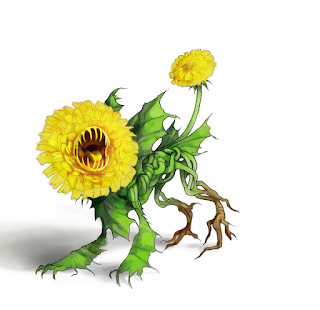I hope you enjoy the taraxacat, and I'll see you next week with another monster.
This vibrant green
plant has a bright yellow flower for a head, complete with toothy maw, and
another for a tail.
Taraxacat CR 4
XP 1,200
N Small plant
Init +8; Senses low-light vision; Perception +9
DEFENSE
AC 18, touch 16,
flat-footed 13 (+4 Dex, +1 dodge, +2 natural, +1 size)
hp 37 (5d8+15);
regeneration 2 (acid or fire)
Fort +7, Ref +5, Will +3
Defensive Abilities
embedded; Immune plant immunities
OFFENSE
Speed 30 ft.,
climb 10 ft.
Melee bite +8
(1d6+2 plus trip), 2 claws +8 (1d4+2 plus poison)
Special Attacks
pounce
STATISTICS
Str 15, Dex 18, Con 17, Int 2, Wis 14, Cha 11
Base Atk +3; CMB +4; CMD 19 (23 vs. trip)
Feats Dodge,
Improved Initiative, Weapon Finesse
Skills Perception
+9, Stealth +12
SQ reroot
ECOLOGY
Environment
temperate plains or forests
Organization
solitary, pair, or field (3–16)
SPECIAL ABILITIES
Dandy Lion Poison
(Ex) Bite—injury; save Fort DC
15; frequency 1/round for 6 rounds; effect 1d3 Dex and victim must succeed
at an additional DC 15 Fort save or become sickened for 1 round; cure 2 consecutive saves.
Embedded (Ex) If
a taraxacat stands on dirt or soil, it gains a +4 racial bonus to its CMD to
resist bull rush, drag, grapple, and trip attempts.
Regeneration (Ex)
A taraxacat’s regeneration only works in dirt or soil. If the creature does not
take acid and fire damage equal to its total hit points, it beings to
regenerate 1 hour later.
Reroot (Su) Once
per day as an immediate action, if a taraxacat is on soil, it can teleport
itself to another location within the same patch of ground (to a maximum of 600
feet away). This is a teleportation ability.
Taraxacats, or dandy lions, are living dandelions and just
as persistent as their immobile cousins. They can thrive in the worst
conditions, provided they have a modicum of water and sunlight (occasionally
supplemented by fresh meat), and are extraordinarily difficult to destroy. Many
unfortunate souls have stopped taraxacat attacks and made sure the creatures
were no longer moving only to have them spring back to full health minutes
later and renew their attacks. Druids with plant affinities employ taraxacats
as guardians but are careful to keep their numbers down to a minimum, since it
takes little in the way of reproduction among the plant creatures to have them overrun
their habitats. Paradoxically, when their yellow flowers give way to white seed-carrying
florets, they are at their most vulnerable, becoming sluggish and more prone to
harm from acid and fire, the only things that can truly eradicate them. When
they are ready to go to seed, they find secluded locations where they can do so
peacefully.
As taraxacats age, they become larger and they learn to rake
like their lion namesakes. They are also able to quickly grow smaller versions
of themselves. Wild taraxacats rarely live to this advanced age and beyond,
since the creatures they prey upon often torch the fields or woods where they
and their progeny roam.
Taraxacats measure 3 feet in length, stand 2 feet tall, and
weigh 70 pounds.
Taraxacat Companions
Elven druids and others who prefer the company of plants may
opt to take a taraxacat as a plant companion.
Starting Statistics:
Size Small; Speed 30 ft., climb 10 ft.; AC
+2 natural armor; Attack bite (1d6),
2 claws (1d4); Ability Scores Str 11,
Dex 20, Con 15, Int 2, Wis 14, Cha 11; Special
Attacks trip; Special Qualities
low-light vision, regeneration.
4th-Level Advancement:
Ability Scores: Str +4, Dex –2,
Con +2; Special Attacks poison (Frequency 1 round [6], Effect 1d3 Dex damage and victim must
succeed at an additional DC 15 Fort save or become sickened for 1 round, Cure 2 consecutive saves, Con-based DC);
Special Qualities reroot.

